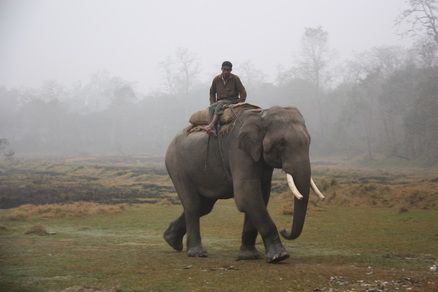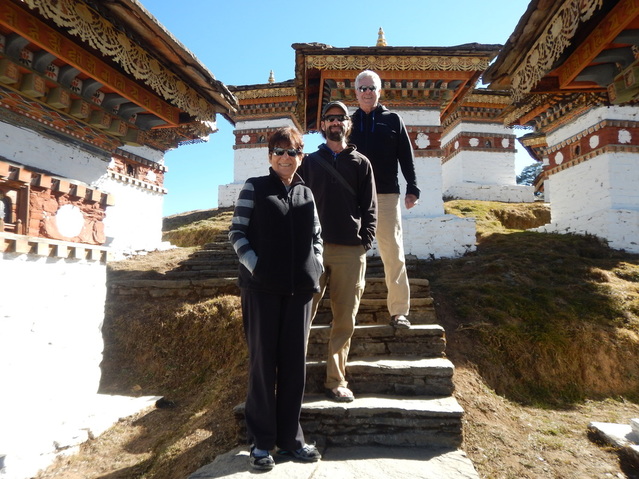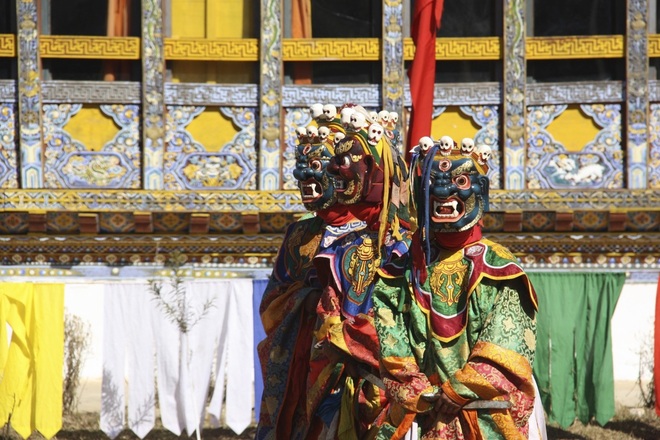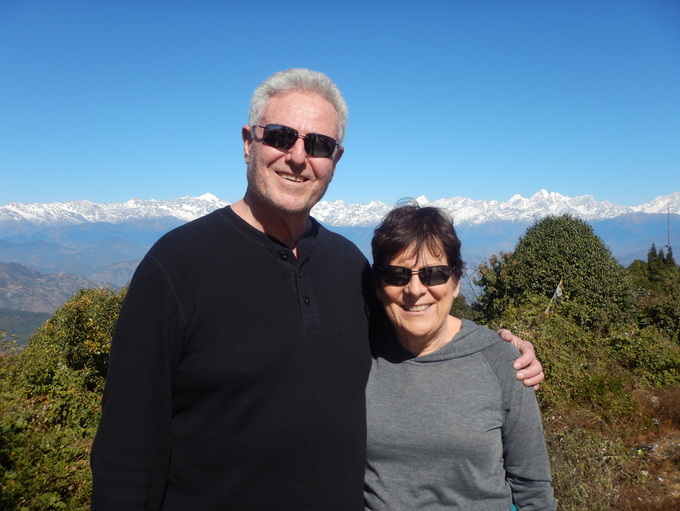
After a typically inefficient visa processing experience, we found Mike and Esther waiting with all of our luggage and piled in to a taxi to nearby Bhaktapur, the City of Devotees. Bhaktapur, Patan, and Kathmandu were three rival kingdoms competing for dominance in the Kathmandu Valley during the reign of the Malla dynasty. Bhaktapur today has the densest collection of temples of the three. It is preserved as a UNESCO World Heritage Site and so is often described as a living museum, having been extensively renovated and restored after a major earthquake in 1934.
Checking in to the adorable Peacock Guesthouse with authentic Newari architecture and woodcarving ornamentation was like staying in our own private museum. Mike and Esther's room came with a carved wooden round window that opened up to watch daily life pass by on Dattatraya Square, as well as door jams low enough for Mike and Matt to bump their heads on.
The remainder of the day and the next were spent wandering between the historically and religiously significant town squares filled with Hindu and Buddhist temples of all different shapes and size. Since Matt and I had also visited Bhaktapur a few months prior when we first rode our bikes into Nepal, I opted to stay back at the hotel and rest from a fatiguing cold I had come down with early on in Bhutan, figuring I had seen it all before.
When they returned a few hours later, Matt showed me photos of processions of locals wearing their best colorful Newari clothes and playing instruments through the cobblestone streets. Apparently this was an auspicious day in the Newari calendar for boys' coming of age ceremonies and celebrations. From the safe distance of a rooftop cafe, they had seen blood squirting above a crowd gathered at a shrine as a water buffalo was sacrificed, then hauled away in pick-up for the family's celebratory feast. Even Potter's Square was filled with rows of pots laid out to dry in the sun; it had been nearly deserted when we had gone there before. And to top it all off, they had successfully located the "Erotic Elephant Temple" where elephants and other animals are depicted in human-style copulation poses. We had searched for it in vain on our previous visit. With the city seeming to be much more alive and vibrant that morning than usual, I regretted my decision to take it easy using an excuse of faulty rationale. It was a biting reminder that there is really no such thing as "seeing it all before." A place is never the same from one day to the next, and it will always hold new discoveries if you approach it with fresh eyes and an open mind.
Having learned my lesson, I rallied for a post-lunch excursion to the Changu Narayan temple, another UNESCO World Heritage Site a few kilometers outside of Bhaktapur. While this was certainly an enjoyable new place to see, there were no parades, sacrifices, or other particularly exciting events to witness, of course!
The next morning we loaded up the Tata Sumo Grande we had rented and met our driver, Ramas, since none of us were equipped with the talent, bravery, or innate understanding of Nepalese driving behavior to dare to do it ourselves. Our driver was immediately put to the test before he even stepped on the gas when a sadhu, or more likely, someone posing as a sadhu, firmly stood in front of the car, holding us hostage until a donation was made. He had been pestering us in a most peculiar way as we were loading up. The gracious owners of the guesthouse had already given him some money and politely requested that he leave us alone, but this only escalated his intensity. Now the owner was not happy about this at all, and basically yanked him out of the way, at which point Ramas peeled out of there in just enough time before the "sadhu" then tried to plaster himself to the side of the car.
With that exciting beginning, the rest of the drive to the UNESCO World Heritage Site of Chitwan National Park seemed uneventful and the roads only mildly curvy after Bhutan. We settled in to Hotel Parkside where we were thrilled to learn that we had their top guide Gopal (rhymes with Nepal) of TripAdvisor fame. It wasn't long after a late lunch and settling in that we were off on our first activity of the three-night package. We took a leisurely walk to a sunset viewpoint on the banks of a peaceful river, well, peaceful except for the fifty other tourists there. Noticing that a nearby riverside bar was strangely devoid of the masses, we wandered over and did our sunset wildlife watching over a cold beer. Within the course of happy hour, we spotted an Asian One-horned Rhino, a wild Asian Elephant, Wild Boar, a gharial and a marsh mugger, both species of crocodiles. Gopal's bird expertise became apparent as he rattled off all sorts of avian White-throated, Black-backed, Long-beaked this and thats within seconds of their fleeting flyby.
While that was certainly a nice introduction to Chitwan, we got the full experience the next day from the back of a sweet mellow elephant. We climbed up a set of stairs to load onto a wooden platform on her back, which was quite cozy with the four of us in it. Her elephant trainer and caretaker, called a mahout, essentially rode on her shoulders and we set off through a forested area adjacent to the park. This may not come as a surprise to you, but for some reason it was for me: riding an elephant is a very rockin' experience, literally. We swayed up and down, back and forth, with each lumbering step. With so many other tourist-ridden elephants going out with us, I figured exciting wildlife would be a no-show. Luckily, rhinos seem to tolerate the presence of people much better when they arrive on an elephant, so we got to watch one up close and personal from the safety of our elephant box.
In the late afternoon, we crossed the river by wading across barefoot with pant legs rolled and actually entered the boundary of the park for the first time. Once across the river, we got a thorough briefing about all the animals that might possibly want to attack us, and what we should or should not do, with most scenarios ending with Gopal beating them off with a stick (except in the case of the angered wild elephant in which case we would all be squashed no matter what we did).
On that encouraging note, he then took us to his secret spot where no other guides take their clients for a nature walk, so the only other people we encountered were local women illegally, but blatantly, gathering wood and plant material to carry out of the park and local men passing by on grazing elephants. The most exciting thing we actually saw was a glimpse of Great Hornbills feeding on a fruiting tree before we scared them off, but according to Gopal we also heard a spooked sloth bear crashing through the forest not far from us, and the low grunt of a tiger. When Gopal heard the persistent yelps of Sambar deer, he took off in their direction through the underbrush and not wanting to be left near any grunting tigers, we had no choice but to follow him. As we got closer, his persistence paid off when we caught a backlit fleeting glimpse of a black mass dropping from the crook of a tree and simply vanishing. He swears we snuck up on a leopard that was causing the agitation of the deer. The reflection of the sunset on the river was beautiful as we crossed back into the "safety" of civilization.
Our third day in Chitwan began with a visit to the government-run elephant breeding center where we got the joy of seeing a little Dumbo playfully roaming around and felt the frustration on a slightly older youngster as he repeatedly pulled against the chain on his leg trying to join the little one in its freedom. The reality is that all of the working elephants, whether for tourists to ride or rangers to use in anti-poaching patrols, are chained on their feet when not working, being bathed, or taken in to the forest to feed. Gopal mentioned that some places are working towards an electric fencing system to replace the chains at least. Perhaps because we are not accustomed to thinking of elephants as domesticated animals, it certainly elicited an emotional response to see them restrained in that way. Yet on a daily basis we would see goats, mules, and water buffalo on equally restrictive short tethers without giving it much thought at all. I wonder if it is our cultural bias at work or simply the charisma of a highly intelligent species that we feel a deeper connection to than livestock.
I contemplated the human-elephant relationship here in Chitwan as we transitioned to a dugout canoe river float. Appropriately, we came upon an elephant drinking from the river's edge. Since the opportunity for tourists to bathe elephants in the river is officially closed during the "cold" winter months, Gopal did the next best thing and asked the elephant's mahout if he could give the elephant a bath as we floated by. With a series of simple commands, the elephant submersed itself while the mahout kept his balance standing on just its spine above the water level. Out came the tip of the trunk like a periscope, or more accurately, a snorkel. The mahout then stepped on one side of the elephant, signaling it to roll like a log while he kept pace on top, then they rotated together to the other side. It was such a graceful demonstration we witnessed that it more than made up for not getting to splash around with one for the sake of our own touristic amusement.
In the afternoon, we went on a "jeep safari" that was a bit disappointing since the vehicle was actually a loud diesel pickup truck with bench seating and a tarp pulled down over a metal roof frame. Not exactly the easiest to see out of, so we were either hunching over to peer out of the little gap between the tarp and the seat, or we had to climb out of the back and stand on the dirt road to see any bird that had caught Gopal's eye, such as a crested serpent eagle perched up in a tree. Nonetheless, we added many more species to our growing list of over one hundred birds, a handful of mammals, and a few reptiles.
For our last evening in Chitwan, we attended a performance highlighting the traditional dances of the Tharu, the first people of Nepal's lowland Terai and the dominant culture until malaria was largely eradicated from the region by using DDT in the 1950s. This opened up the Terai for settlement by highland groups without the Tharu's genetic malarial resistance who quickly gobbled up the essential habitat of so many species as jungle was converted to rice paddies. National parks were established to preserve what remained. Of course, this influx of new people and forcible relocation out of the parks shook the foundations of the Tharu way of life, which they have been struggling to preserve ever since. Based on the enthusiasm and talent of the young dancers as they rhythmically clashed sticks together in mock choreographed fights, it seems that at least this aspect of the culture won't be disappearing any time soon.
During one last pre-breakfast bird-focused walk where we got a smidge closer to seeing a respectable number of Chitwan's 569+ bird species, I labeled myself an "opportunistic birder." If I have someone knowledgeable and excited about birds pointing them out to me, then I get pretty in to it too. Otherwise, I don't really pursue figuring out the nuances of name. The petite electric blue White-throated Kingfisher would still be my favorite whether I knew its common, genus, and species names or not.
We were back on the road after breakfast and headed to...you guessed it, another UNESCO World Heritage Site! This time it was Lumbini, very close to the border with India, and the source of Nepal's decorative truck slogans declaring "Buddha was born in Nepal!" We rented decrepit single-gear bikes to cruise around the extensive site, aptly described as an "Epcot Center of Buddhist Temples." We started with an understated one representing Sri Lanka, but fortunately they got more exciting from there. The dramatic architecture of Thailand's white marble temple was striking despite being under renovation, Myanmar was a mini version of its golden Hershey kiss-shaped temples depicted in so many promotional photos of the country, and China was a trip down memory lane.
We cycled beyond the rows of national temples paying homage to Buddha to a World Peace Pagoda surrounded by a Sarus Crane Preserve. We didn't spy any cranes from there, but as we walked around the bizarre grounds of the Cambodia temple, we were lucky enough to observe one at close range, at least until a Chinese tourist got too close and scared it off. Having seen the many features of Lumbini honoring Buddha, we finished our day with a visit to the remains of the Maya Devi Temple, where the exact spot of his birth is believed to be. While pedaling around the large complex known as the Lumbini Development Zone all day was enjoyable enough, it was not as developed as the name had led us to expect. Many plots of land stand empty, presumably awaiting countries to build their representative temple there. While the temples themselves were well cared for, the overall area felt unmaintained. Perhaps being quite different than we expected also made it more exciting as we were never sure what we would come across next.
Our time in the Terai was short and our exploration was not thorough, but it was insightful and important to see a new region of Nepal, one that is geographically, climatically, and culturally closer to India than the Himalaya. It gave us a firsthand appreciation of all the forms of diversity that make up this compact country.




 RSS Feed
RSS Feed
